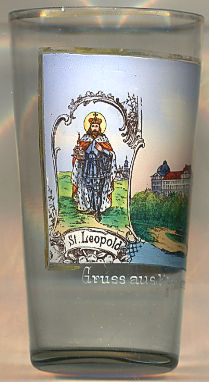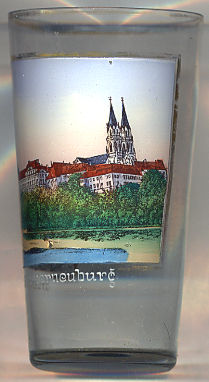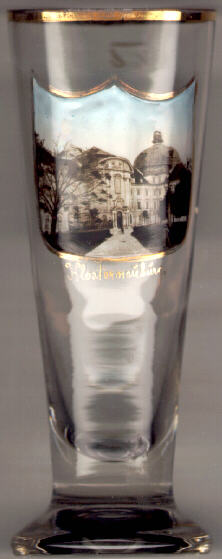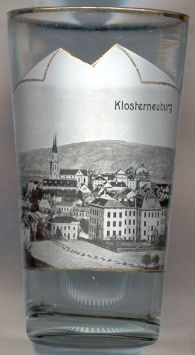

|
| ÖSTERREICH | AUSTRIA |
| Bundesland: Niederösterreich | Lower Austria |
| Bezirk: Tulln |
The history of Klosterneuburg goes back to the 12th century when the Babenberg Margrave Leopold III (the Saint) resided here. Under the first Habsburg Duke of Austria, Albrecht I, Klosterneuburg obtained the freedom of the city in 1298. In 1529 and in 1683 Klosterneuburg was destroyed by the Turks. Together with Gugging, Höflein, Kierling, Kritzendorf, Weidling and Weidlingbach it became part of Vienna (Groß-Wien, Greater Vienna) in 1938 (26th district, Klosterneuburg). In 1946 the Nationalrat (National Assembly) decided to return these municipalities to Lower Austria. However, it took until 1954 that the Allied Council agreed. Since then Gugging, Höflein, Kierling, Kritzendorf, Weidling and Weidlingbach are boroughs of the newly-formed municipality of Klosterneuburg, which by that became the third-largest municipality in Lower Austria. Klosterneuburg was the administrative seat of the district Wien-Umgebung until the district's dissolution on 31 December 2016; since then, the municipality is part of the district Tulln.

 The famous
The famous  monastery was founded by Margrave Leopold III of Austria in 1108.
Leopold had been a follower of Emperor Heinrich IV
but then supported the emperor's son and enemy, the later Emperor Heinrich V.
According to the legend, the veil of Leopold's wife was taken away by a blow of the wind but was found
completely undamaged 9 years later in an elderberry tree. Leopold saw this as
a sign of God and founded the monastery on the spot where the veil had been found.
On the advice of his son, bishop Otto of Freising, he gave the monastery to the Augustine Canons in 1133.
Until 1568 Augustine canonesses also had a convent here.
A new flourishing period of the monastery was initiated when Pope Innocens III
canonized Leopold III in 1485; since 1663 Leopold is the patron saint of (Lower and Upper) Austria and Vienna.
monastery was founded by Margrave Leopold III of Austria in 1108.
Leopold had been a follower of Emperor Heinrich IV
but then supported the emperor's son and enemy, the later Emperor Heinrich V.
According to the legend, the veil of Leopold's wife was taken away by a blow of the wind but was found
completely undamaged 9 years later in an elderberry tree. Leopold saw this as
a sign of God and founded the monastery on the spot where the veil had been found.
On the advice of his son, bishop Otto of Freising, he gave the monastery to the Augustine Canons in 1133.
Until 1568 Augustine canonesses also had a convent here.
A new flourishing period of the monastery was initiated when Pope Innocens III
canonized Leopold III in 1485; since 1663 Leopold is the patron saint of (Lower and Upper) Austria and Vienna.
The  monastery and parish church Unsere Liebe Frau (Our Lady)
was founded in 1114 and consecrated in 1136. After a fire in 1158, the church was rebuilt. The lower part of the south tower
was completed in 1592, the lower part of the north tower was built in 1637–1644. Both towers were remodelled in Neo-Gothic style in
1887–1892 by the architect Friedrich von Schmidt. At the same time the outer parts of the church were reshaped in Neo-Romanesque style.
The interior of the church had been decorated in Baroque style during the 17th century.
The church received the papal title of a Basilica minor in 1936.
monastery and parish church Unsere Liebe Frau (Our Lady)
was founded in 1114 and consecrated in 1136. After a fire in 1158, the church was rebuilt. The lower part of the south tower
was completed in 1592, the lower part of the north tower was built in 1637–1644. Both towers were remodelled in Neo-Gothic style in
1887–1892 by the architect Friedrich von Schmidt. At the same time the outer parts of the church were reshaped in Neo-Romanesque style.
The interior of the church had been decorated in Baroque style during the 17th century.
The church received the papal title of a Basilica minor in 1936.
(see also list of other basilicae minores depicted on glasses of this collection)
Among the many treasures of the monastery is the Verdun altar in the burial chapel for Leopold III, the former chapter house of the 12th century. The winged altar was created in 1329 out of 51 enamel plates on gilded copper which had been created in 1181 by Nikolaus (Nicholas) of Verdun who also worked on the shrine of the Three Kings in the cathedral of Cologne.

 The new tract of the monastery, the
The new tract of the monastery, the  Residenztrakt
Residenztrakt
![[scale]](lineal.jpg)